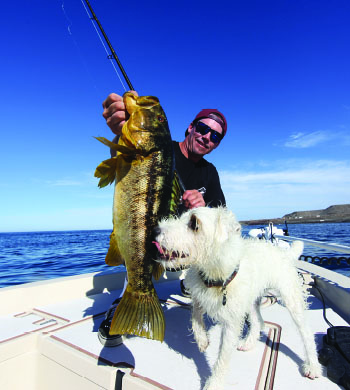 Put plainly, running to San Clemente Island is a commitment that many private boaters are reluctant to make. The main reason is that it’s a pretty damned long run from any launch ramp, the shortest being the 55-mile crossing between Newport Harbor and the west end. Factor in unpredictable naval closures and a general lack of private boater fishing intel coming from the island and you’re left with a pretty strong argument to fish closer to home.
Put plainly, running to San Clemente Island is a commitment that many private boaters are reluctant to make. The main reason is that it’s a pretty damned long run from any launch ramp, the shortest being the 55-mile crossing between Newport Harbor and the west end. Factor in unpredictable naval closures and a general lack of private boater fishing intel coming from the island and you’re left with a pretty strong argument to fish closer to home.
But this article isn’t about staying closer to home. It’s about fishing San Clemente Island. So I asked some professional guides, who fish the island regularly, to share some pointers on how to make that long run pay off.
The island’s calico bass fishery seems to get the most coverage these days, but there are still plenty of opportunities for those who consider calicos a by-catch. Captain Brandon Hayward is definitely one of those guys and he does plenty of non-calico damage on his 23-foot Parker Pilot House. “I’m usually pegged for the coastal white seabass thing, but Clemente is my favorite place to fish, especially early and late in the season; February and October,” Hayward explained.
“My earliest memories of Clemente were fishing yellowtail at White and Purse Seine rocks on the anchor on sportboats; usually with squid, usually in March and April. Classic post-gray swim-throughs where the fish would come up the ridge; we were anchored and on bite before continuing up or down the island. I spent a lot of time in that zone this past fall on charters, but the seals made it impossible to fish on the anchor.”
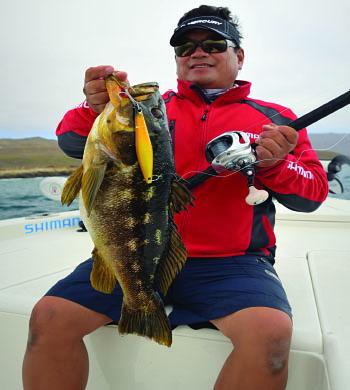 While seals are a problem at the island, Hayward suggests that by modifying your techniques you can work around them.
While seals are a problem at the island, Hayward suggests that by modifying your techniques you can work around them.
“We troll a lot these days because it gives us a better chance against the seals,” he explained. “But we’re not just randomly dragging baits around, we’re trolling along those same ridges that we used to anchor on. So instead of waiting for the yellows to come to us, we bring our baits to them.”
PRACTICAL PLOTTING
“Clemente is one of those places you can fish off your plotter,” Hayward observes. “There are both shallow and deep ridge lines running along most of the island and the irregularities, like knuckles and offshoots, of those ridges are what aggregate bait and attract fish. If we were going to fish deep water yellowtail and someone told me I could only use my meter or my plotter to work with, I’d choose my plotter; a Furuno NavNet TZ9. If you are just dipping your toes into Clemente, look at topographical charts on your plotter. See all those ridge lines, and how they stack up close to each other, especially on the ends of the island? These are the areas that you’ll want to investigate.”
The eastern part of the island’s backside is another one of Hayward’s favorite zones.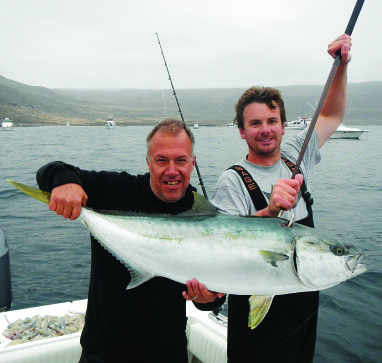
“Clemente’s squid nests pretty much always hold, especially from May on,” he notes. “While getting on one by yourself, or with a light crowd is great and sounds good on paper, most of the times they are going to get crowded. If you come racing through Pyramid Cove at 6 a.m., good luck on getting a decent spot.
“A couple years ago I made my June fishing Clemente. I’d always be there in the afternoon, sometimes getting a pick on the seabass, but having the opportunity to motor around at night and find the best concentration of squid. Instead of anchoring in the middle of the nest, I would always try to get on an edge of it. If you can sew up a little edge, or an entire bottom or top of the leading edge, you are not going to get surrounded.”
In closing, Hayward had this to offer: “There are not that many private boaters who really know the backside of Clemente, outside of the bass world. I am certainly not one of them. I just do what I do local: Sit and wait and soak it out if I know that the fish are there. Other times you have to look and find them. The best way to pick up on Clemente is through osmosis. Working on sportboats and fishing with different skippers helped lay my foundation. Then when I became a ‘skiff guy,’ I started using recall—and trying some stuff that just looked good on the plotter.”
BACKSIDE BOILERS
Speaking of bass fishermen who really know the backside of Clemente, Captain Benny Florentino has spent decades getting to know every inch of the island and fishes it regularly on his 24-foot Ranger Bahia.
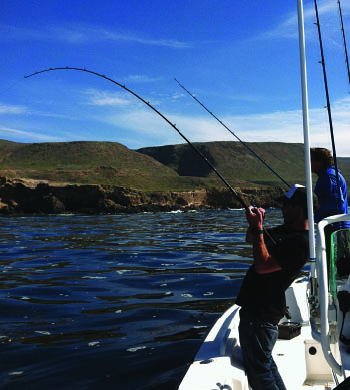 “I love fishing bass in shallow water and the backside east end of the island is one of my favorite spots to do it,” Florentino says. “There are so many good boiler zones between Pyramid and China Point that you could fish there the entire day and not cover them all.”
“I love fishing bass in shallow water and the backside east end of the island is one of my favorite spots to do it,” Florentino says. “There are so many good boiler zones between Pyramid and China Point that you could fish there the entire day and not cover them all.”
The boiler zones that Florentino is referring to are areas where the water meets a rocky shoreline and the swells create turbulent water, which calicos use to ambush prey.
“Fishing tight in an area with a lot of surge is a dangerous proposition if you’re unfamiliar with the area,” Florentino warned. “I always tell guys to err on the side of caution when fishing a new zone. If you’re unfamiliar with the layout of a reef or rocky shoreline, you should watch the area for a while before pulling in. It might take 10 minutes out of your day, but it’s better than pulling in and finding out that every five minutes a big swell rolls through and wipes out the entire reef. Most of the guys that have wrecked their boats doing this have gotten caught inside in an unfamiliar area when a big swell rolled through.”
Florentino says that even when he is fishing a zone he is very familiar with, he will always leave the main motor running and never fish with his back to the water.
“Always keep an eye out and be ready to take evasive action if necessary,” he advises. “I’ll also keep the boat angled in a direction that will allow me to run safely out of the zone if necessary. I see some less experienced guys pull in, drop the troller and fish with there boats pointed at the beach and their backs to the water. That’s just a recipe for disaster.”
With the safety precautions covered, Florentino broke down his approach to fishing the island.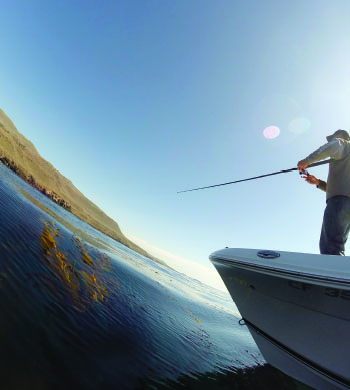
“All of the fishing that I’m doing is in one to 20 feet of water and I’m doing most of it with just a couple of setups. If I’m fishing a swimbait I’m going to go big and use a 9-inch Big Hammer Sledge Hammer rigged on a 1- to 1 ½-ounce Warbaits Slayer Head. I like darker colors and will usually fish the Toast color or the Red Calico Hunter on a similarly colored head. Since I’m trying to pull fish out of structure, I only use heavy gear. My go to setup is a Shimano Curado 300EJ matched to a 711H Teramar rod, with 65-pound Power Pro Spectra and a 50-pound fluorocarbon leader. When I’m not fishing the swimbait I’m throwing a Tady 45 on a 90H Teramar and a TranX 500 with 80-pound Power Pro and a 60-pound leader.”
Regardless of which bait he’s fishing, his presentation is basically the same.
“I’ll position my boat in a way that will allow me to cast my bait up into the turbulent water, then I’ll retrieve it at a medium to fast pace,” Florentino says. “A lot of guys slow their presentation down during the winter, but I fish the same all year long. If there are bass up in the surge, they’re actively feeding and will have no problem chasing down your bait.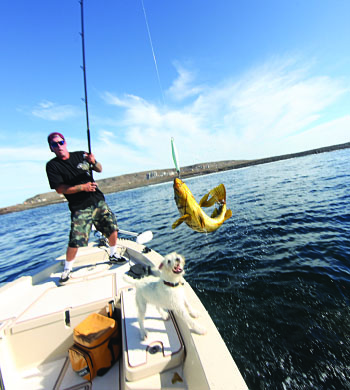
“There is no set formula for which areas are going to produce the most bites, but I’ve always had good results in areas that have rocks with rag kelp around them and lots of surge with some foam that’s next to clean water. If I find a zone like that I’ll usually fish the surface iron parallel to that dirty water edge. I’ve caught a lot of big bass that were using that dirty water as an ambush point.”
DECKER DIARIES
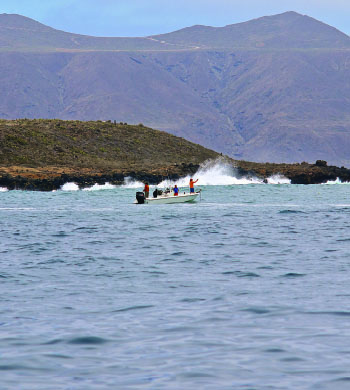 When it comes to ambush points, the kelp beds that span the backside of the island provide some of the best calico action you’ll find on the coast. Captain Jimmy Decker is no stranger to those beds and had some pointers for targeting calicos in the kelp.
When it comes to ambush points, the kelp beds that span the backside of the island provide some of the best calico action you’ll find on the coast. Captain Jimmy Decker is no stranger to those beds and had some pointers for targeting calicos in the kelp.
“I fish completely opposite of the way Benny does,” Decker said after I told him about my interview with Florentino. “I’ll always start at the west end of the island and fish my way down the back. I’m also not in a big hurry to get there first thing in the morning. I know that the stuff Benny fishes bites best early, but the kelp never seems to bite well before 9 or 10 in the morning, so I’ll leave the dock at dawn and cruise over.
“Once I get to the island, I’ll spend a few minutes looking at conditions before rigging up my tackle. I’m checking for water color and clarity and also light conditions; if it’s a cloudy day with off color water I’ll start with a darker bait. If the sun comes out or the clarity improves, I’ll go to a lighter colored bait.”
Decker’s bait of choice is an LK Lures weedless swimbait.
“I’ll fish either the 7-inch or 9-inch LK on an Abu/Garcia Revo Inshore full of 40-pound Berkley Pro-Spec Braid and a 40-pound Pro-Spec fluorocarbon leader,” he reports. “I’ve got a couple different rods that I like for this but I usually fish my Volatile 80-6 (which is an 8-foot heavy action rod). The gear I fish is a lot lighter than what most guys are using these days. I believe in fishing the tackle you’re comfortable with instead of changing just because that’s what everyone else is doing.”
The same holds true for how one fishes an area, Decker notes.
“You need to find your own rhythm. Kelp beds basically fish the same wherever they are, so I’ll start casting and let the fish tell me what they want on that day. Sometimes they want the bait coming with the current, other times they’ll only bite if you fish against it. Could be a fast wind bite or they might want it slow. Just keep trying different things until you start catching fish and fine-tune it from there.”
DETAILS, DETAILS
The devil is in the details when fine-tuning a bite, and Captain Duane Mellor of Seasons Sportfishing is one of the best at quickly assessing and assembling the puzzle pieces. “To fully take advantage of a bite, you need to be able to understand what’s happening, why it’s happening and how you can exploit it,” Mellor explained.
“But before you do any of that you need to find areas that have a high probability of holding biting fish. The first thing I’ll look at is the conditions. If I’m fishing a kelp bed I’ll look for current that has the stringers running up or down the island. You can get bit when the current is running toward the beach or out to sea, but it usually makes for tough fishing. You’re kind of stuck with the water temp, color and clarity that the island has on any given day, so I wouldn’t worry too much about that. Once you’ve found some kelp with current, you’re going to want to find where the food source is in relation to the bed.”
 He advises looking to birds as the best indicator.
He advises looking to birds as the best indicator.
“If you see birds flying around or diving on a particular part of the bed, that’s probably where the fish are biting,” Mellor says. “If there are birds sitting in a group near the kelp there’s a good chance that there was something biting there earlier, so it’s worth a look. If there aren’t any birds around I’ll look for bait. If the bait looks relaxed I’d keep looking but if it’s darting around looking scared then you’re in the right spot. If you can find an area of kelp or shallow reef with current, birds and bait it’s pretty much a guaranteed that you’re gonna be tight on big bass at the island, all day long (or until the conditions peter out).”
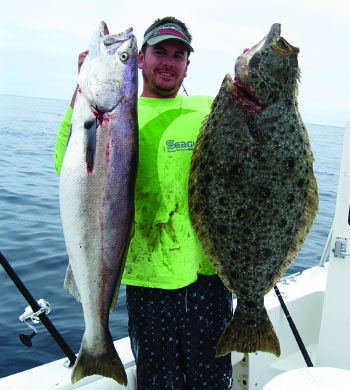 Mellor’s weapon of choice when targeting calicos at San Clemente is the surface iron.
Mellor’s weapon of choice when targeting calicos at San Clemente is the surface iron.
“I’ll fish a Shimano Terramar 90XH or Calstar GG90J paired with Shimano Trinidad 20A filled to the top with 65-pound Power Pro and four to five feet of 50-pound fluorocarbon. I recommend fishing whatever jig stick you’re comfortable with, just make sure you get the right jig. I fish Tady 45’s and Starmann 112’s. Getting bit is a combo of matching the hatch and using the best swimming jigs you can find. Mediocre swimmers just don’t get bit as well. If it comes down to it I’ll sacrifice color for a good swimming jig. I’d rather fish a neon green jig that swims good, than a jig painted just like a sardine that swims like crap. But if you can get the best out of both worlds, prepare to have some sore arms by the end of the day.”

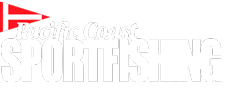
Very beautiful
Reminder of access restrictions near San Clemente Island, per standing USCG published Notice to Mariners:
Due to Naval Training Exercises throughout the year, mariners operating in the vicinity of San Clemente Island are reminded of the restricted waterway access surrounding San Clemente Island (33 CFR 165.1131; 33CFR 165.1141). Since the inception of the regulations, numerous safety zone violations have been processed by Coast Guard Sector San Diego. Safety Zone Incursions put the public at risk and cause costly and unnecessary training delays, as well as range cancellations. Violators of the San Clemente Island Safety and Security Zones are subject to monetary penalties. Criminal penalties may also be issued for repeated Safety and/or Security Zone violations. Failure to comply with the federal regulations could result in civil penalties of up to $40,000.00. Furthermore, if a mariner holds a Merchant Mariner Credential, suspension or revocation action may be pursued against the mariner’s credential. The U.S. Navy makes every effort to maintain a schedule in advance and minimize public access restriction. For more information and to check on updated periods of enforcement, please visit the Navy’s public website for the island (www.scisland.org).